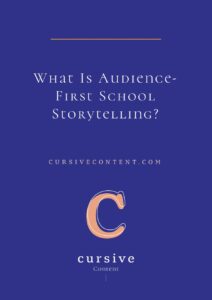What Is Audience-First School Storytelling?

I have a huge stack of favorite books from when I was a kid: The Witch of Blackbird Pond … Anne of Green Gables … The Neverending Story … the list goes on and on (and on and on).
So naturally, because I have two daughters who should (in theory) share at least some of my own childhood traits, I’ve eagerly filled their bookshelves with these amazing stories.
Every single night, I ask to read one with them.
And every single night, without fail, they turn me down.
Instead, they want to hear one of my husband’s “made-up” stories: insanely silly, nonsensical, rambling tales filled with astronaut cats who save the world, talking vegetables with bad attitudes, and little girls who are secretly superhero spies.
Why do they prefer these ridiculous bedtime stories over my stack of Newbery-Medal winners?
Because these stories were made specifically for THEM.
New: Audience-First School Storytelling Kit
Want to learn exactly how to win over dream families with breakthrough school storytelling? This on-demand kit includes instant access to:
- In-depth video workshop
- Workshop workbook
- Family survey template
- Email template
- Voice of Customer research spreadsheet
- Audience persona template
- Sample dream family persona
Those astronaut cats? They look and act suspiciously like our two cats. The vegetables? They just happened to have been on our dinner plates that night. And those little girls? They’re sitting there in bed, listening with bright eyes and eager imaginations.
When a story is crafted just for you, it gets your attention — and leaves you wanting more.
THAT’S audience-first storytelling.
The concept of audience-first storytelling really begins with the definition of the word “story” itself:
story: a narrative, either true or fictitious, in prose or verse, designed to interest, amuse, or instruct the hearer or reader; tale.
Notice how nowhere in this definition does it talk about the teller or the writer of the story. Instead, a story is all about the hearer or the reader — it’s all about amusing or instructing your audience. When you tell a story, you’re telling it for THEM, not for you.
Thinking about “story” in this way is critical for school marketers.
Too often, we think about telling a school story from the school’s point of view. Your school is the center of the story, and you want your audience to understand what makes you so great. Want an example? Read your school’s mission statement. Do your dream families or students make an appearance, or is it more about what your goals and values are as an institution?
As a school marketer (actually, let’s call you school storytellers because that’s what you really are), it’s your job to make your school’s mission relevant to your dream families.
You need to deeply understand your prospective students and families and use those insights in a way that is meaningful to them and what they care about — their wants and needs, their concerns, their challenges, their hopes and dreams.
How do you do that? Let’s simplify it into two main steps:
Know your audiences.
Know your school’s “sweet spot.”
The first step involves doing Voice of Customer (VOC) Research, which is exactly what it sounds like: capturing the real, authentic voice of your dream families as they describe the things that matter to them: things like their interests, worries, how they define success, what they care about, what their ideal school looks like. You can then create Audience Personas that will help guide you in the creation of an audience-first school story.
Once you know who you’re speaking to, you need to be able to capture their attention quickly. There’s so much information competing with your story, so you need to be bold in your stance to be noticed. You cannot afford to be vague in your promise and personality. Instead, you have to confidently define your school’s “sweet spot.”
Joe Pulizzi says in his book Epic Content Marketing:
“Your sweet spot is the intersection between your customers’ pain points and where you have the most authority with your stories. Where can you be the leading expert in the world?”
What is it that you do best? What is it that every student at your school will walk away with? Audience-first school stories stand out by making a bold statement that their dream families truly care about.
Telling an audience-first school story requires some work, but it’s worth it.
Having an audience-first school story is incredibly powerful. It allows you to:
- Appeal directly to your audience’s specific wants and needs, and address their challenges and hesitations upfront.
- Ensure all school communications are consistent, highlighting your true outcomes, benefits, and differentiators.
- Gives all constituents—faculty, staff, alumni, parents—the tools they need to help share your story and become your biggest advocates.
- Provides content creators with a foundation to work from for all marketing and communications projects.
- Strengthens your school’s authority in your specific areas of expertise.
So, where do you begin? Because this is one of the most common topics school storytellers ask me about, I’ve gone ahead and done some of the homework for you.
The Audience-First School Storytelling Kit is an on-demand toolkit designed to help you understand your audience’s mindset so that you can attract dream families, increase inquiries & enrollment, strengthen communities, and grow school influence.
This kit will help you capture the real, authentic voice of your dream families as they describe their interests and worries, how they define success, what they care about, what their ideal school looks like, and any preconceptions they might have about your school or schools like yours — and translate that research into a standout school story.
It includes all of the materials I use to do this work for my school clients, which I’ve turned into templates that you can copy and customize to use today, such as:
- In-depth video workshop
- Workshop workbook
- Family survey template
- Email template
- Voice of Customer research spreadsheet
- Audience persona template
- Sample dream family persona
If you’re interested in telling an audience-first school story this year, this is the perfect place to start.
I can’t wait to watch as you create and share stories your audiences will love!
MORE ARTICLES
-
 What Is Your Private School’s Bold & Unifying Big Promise?
What Is Your Private School’s Bold & Unifying Big Promise? -
 Viewbook Best Practices for Private Schools
Viewbook Best Practices for Private Schools -
 AI Writing Prompts to Power Private School Storytelling
AI Writing Prompts to Power Private School Storytelling -
 When to Outsource Your Private School Content Marketing to an Expert
When to Outsource Your Private School Content Marketing to an Expert -
 How to Write a Magnetic Private School “About” Page
How to Write a Magnetic Private School “About” Page -
 The Ultimate Call-to-Action for Every Private School Marketing Situation
The Ultimate Call-to-Action for Every Private School Marketing Situation -
 3 Unique Ways to Attract Dream Families with Content
3 Unique Ways to Attract Dream Families with Content -
 How to Write a Compelling School Magazine Article People Want to Read
How to Write a Compelling School Magazine Article People Want to Read


